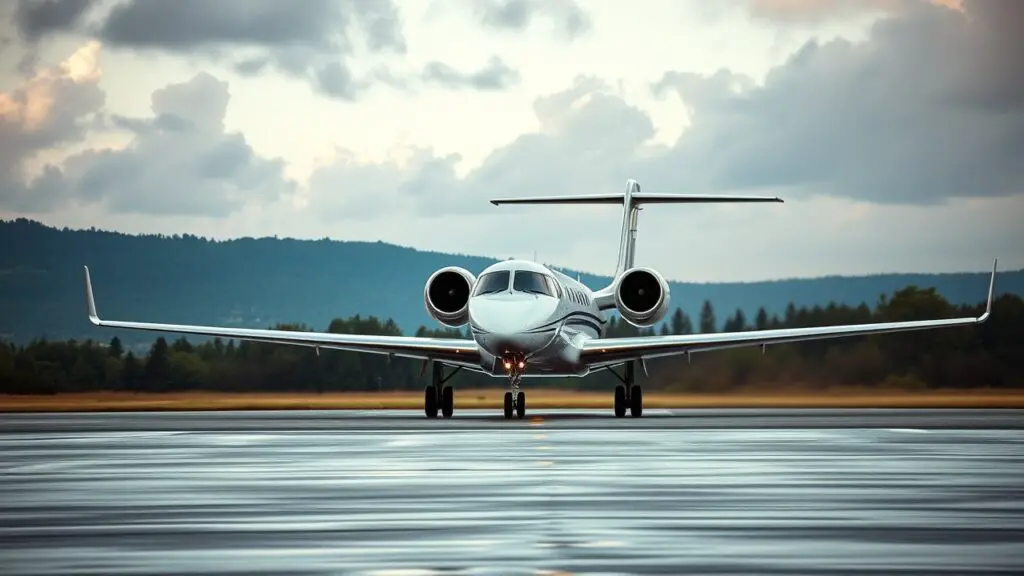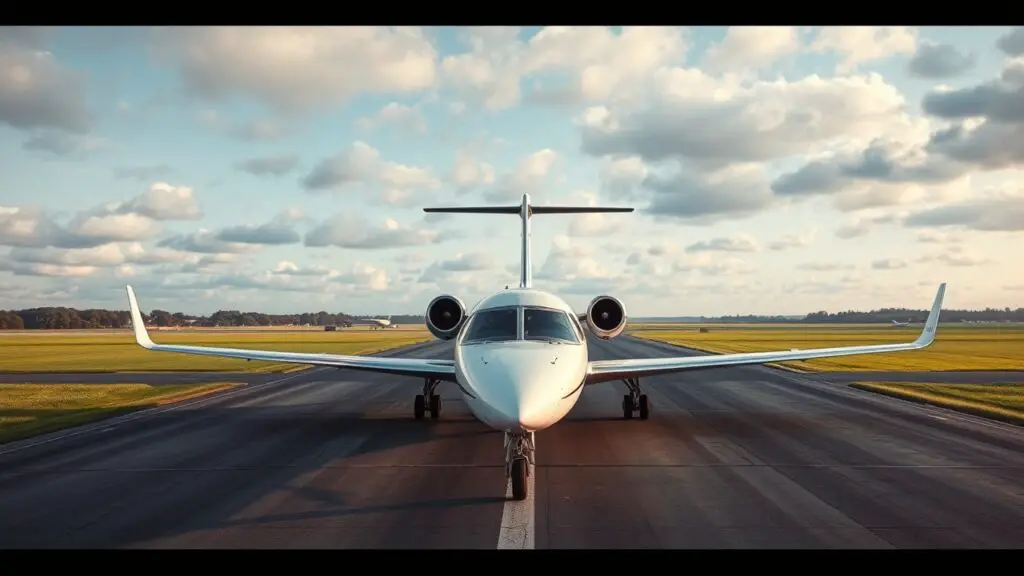Landing a private jet is a complex and highly demanding process that necessitates exceptional precision and attention to detail.
The pilot initiates the landing sequence by meticulously monitoring the aircraft’s speed, altitude, and position in relation to the runway.
Contents
As the jet approaches the airport, the pilot must navigate through air traffic, adhering to specific flight paths to ensure a safe and efficient landing.
Once cleared for landing, the pilot must expertly maneuver the aircraft onto the runway, taking into account factors such as wind speed and direction, runway conditions, and adjacent air traffic.
The pilot then executes a controlled descent, utilizing the jet’s landing gear to make a smooth touchdown on the runway.
Throughout the entire process, the pilot must remain vigilant and alert, prepared to make rapid decisions in response to unforeseen obstacles or challenges.
Landing a private jet demands an exceptionally high level of skill, expertise, and comprehensive knowledge of the aircraft’s capabilities and limitations.
Pilots must undergo rigorous training and certification programs to ensure their ability to safely land a private jet in diverse conditions.
Furthermore, pilots must maintain their skills and knowledge by regularly undergoing proficiency checks and staying current with their training.
Landing a private jet is a complex and challenging task that requires extensive training and experience to perfect.
It involves meticulous planning, precise execution, and a high level of skill and expertise.
Overall, mastering the process of landing a private jet is not something that can be achieved easily, and it demands a significant amount of practice and dedication.

Safety Measures for Private Jet Landings
Additionally, pilots must carefully assess weather conditions and air traffic to plan a safe approach and landing.
During the landing process, pilots must maintain precise control of the aircraft and be prepared to make split-second decisions in case of any unexpected challenges.
Once the jet has safely touched down, pilots must continue to follow safety procedures to ensure that passengers and crew can disembark without any incidents.
Overall, safety is the top priority for private jet pilots during the landing process to ensure a smooth and secure arrival for everyone on board.
During the approach and landing, pilots must constantly monitor the aircraft’s performance and be prepared to respond to any potential issues or emergencies.
Additionally, pilots must be aware of and adhere to all air traffic control instructions and regulations to ensure safe and efficient operations at all times.
In addition to the pilot’s responsibilities, there are also numerous safety measures in place at airports to ensure the safe landing of private jets.
Airports are equipped with advanced runway lighting systems, navigational aids, and ground support personnel to assist pilots during the landing process.
Runway inspections are regularly conducted to ensure that runways are free from debris, obstructions, or other hazards that could pose a risk to landing aircraft.
Overall, safety measures for private jet landings are comprehensive and multi-faceted, involving both the pilot’s expertise and vigilance as well as the infrastructure and support systems in place at airports.

Factors Affecting Private Jet Landings
There are numerous factors that can affect the landing of a private jet, ranging from environmental conditions to technical considerations.
Environmental factors such as wind speed and direction, visibility, and weather conditions can all have a significant impact on the landing process.
Pilots must carefully assess these factors and make adjustments to their approach and landing techniques as necessary to ensure a safe and smooth landing.
Additionally, runway conditions such as surface type, length, and slope can also affect the landing process, requiring pilots to adapt their approach and techniques accordingly.
Technical considerations such as aircraft performance, weight and balance, and system functionality can also play a critical role in private jet landings.
Pilots must carefully monitor these factors throughout the landing process and be prepared to make adjustments as necessary to ensure a safe and successful landing.
These factors can include weather conditions, air traffic control instructions, runway length and condition, and the presence of other aircraft in the vicinity.
Pilots must constantly assess and adjust their approach and landing procedures to ensure a smooth and safe arrival.
Additionally, they must be prepared to make quick decisions and adjustments in the event of unexpected changes or emergencies.
By staying alert and responsive, pilots can effectively manage these factors and ensure the safety of their passengers and crew.

The Importance of Proper Training for Private Jet Landings
Proper training is essential for pilots to safely and effectively land a private jet.
Pilots must undergo extensive training and certification to ensure they have the knowledge, skills, and experience necessary to handle the complexities of private jet landings.
Training programs cover a wide range of topics including aircraft systems, flight operations, navigation, weather analysis, emergency procedures, and more.
Additionally, pilots must complete regular proficiency checks and ongoing training to maintain their skills and stay current with industry best practices.
In addition to technical training, pilots must also develop strong decision-making skills, situational awareness, and the ability to remain calm under pressure.
These soft skills are just as important as technical expertise when it comes to safely navigating through the challenges of private jet landings.
Proper training is crucial for pilots to confidently and competently handle the complexities of private jet landings.
This includes understanding the specific characteristics and performance capabilities of different types of private jets, as well as mastering the techniques for landing in various weather conditions and at different airports.
Additionally, pilots must be well-versed in emergency procedures and be able to make split-second decisions in high-pressure situations.
With the right training, pilots can ensure the safety and comfort of their passengers while navigating the challenges of private jet landings.

Common Challenges Faced During Private Jet Landings
Private jet landings can present a number of challenges for pilots, requiring them to remain vigilant and adaptable throughout the process.
One common challenge is navigating through adverse weather conditions such as strong winds, turbulence, or low visibility.
Pilots must carefully assess these conditions and make adjustments to their approach and landing techniques as necessary to ensure a safe and smooth landing.
Another common challenge is managing air traffic congestion and coordinating with air traffic control to safely navigate through busy airspace.
Technical challenges such as aircraft performance limitations or system malfunctions can also pose significant challenges during private jet landings.
Pilots must be prepared to respond quickly and effectively to these issues in order to ensure a safe landing.
Private jet landings present a number of common challenges that require pilots to remain focused, adaptable, and prepared to make split-second decisions.
These challenges can include dealing with adverse weather conditions, navigating complex air traffic control instructions, and adjusting to different runway lengths and surfaces.
Pilots must also be prepared to handle unexpected mechanical issues or other emergencies that may arise during the landing process.
Additionally, they must be able to quickly assess and respond to any changes in the aircraft’s performance or behavior in order to ensure a safe and smooth landing for their passengers.
Overall, the ability to effectively manage these challenges is crucial for private jet pilots in order to ensure the safety and comfort of their passengers.

The Role of Air Traffic Control in Private Jet Landings
Air traffic control plays a critical role in ensuring the safe and efficient landing of private jets.
Air traffic controllers are responsible for managing airspace, coordinating aircraft movements, providing guidance and instructions to pilots, and ensuring that all aircraft operate in accordance with established regulations and procedures.
During the landing process, air traffic controllers provide pilots with critical information such as runway assignments, weather updates, traffic advisories, and clearance for approach and landing.
Air traffic controllers are responsible for coordinating the movement of aircraft to prevent congestion and maintain safe distances during the approach and landing phase.
Their role is crucial in ensuring the safety of all aircraft, including private jets, as they navigate through busy airspace.
By providing pilots with essential support and guidance, air traffic control plays a vital role in the successful and safe landing of private jets.

Best Practices for Private Jet Landings
There are several best practices that pilots should follow to ensure safe and successful private jet landings.
First and foremost, pilots should conduct thorough pre-flight checks to ensure that the aircraft is in optimal condition for landing.
Throughout the approach and landing process, pilots should carefully monitor environmental conditions such as wind speed and direction, visibility, and weather updates in order to make informed decisions about their approach and landing techniques.
Pilots should also maintain open communication with air traffic control throughout the landing process, following all instructions and guidance provided by controllers.
Additionally, pilots should be prepared to make adjustments to their approach and landing techniques as necessary in response to changing conditions or unexpected challenges.
Overall, following these best practices can help pilots navigate through the complexities of private jet landings with confidence and competence.
Landing a private jet is a complex and demanding task that requires careful planning, precise execution, and a high level of skill and expertise.
Safety measures for private jet landings are comprehensive and multi-faceted, involving both the pilot’s expertise and vigilance as well as the infrastructure and support systems in place at airports.
There are numerous factors that can affect private jet landings, requiring pilots to remain vigilant and adaptable in order to safely navigate through these challenges.
Proper training is essential for pilots to confidently and competently handle the complexities of private jet landings.
Private jet landings present a number of common challenges that require pilots to remain focused, adaptable, and prepared to make split-second decisions.
Air traffic control plays a critical role in ensuring the safe and efficient landing of private jets.
By following best practices, pilots can ensure that they are well-prepared to handle the complexities of private jet landings with confidence and competence.
This includes thorough pre-flight planning, understanding the specific requirements and procedures for each destination, and staying current with the latest regulations and safety protocols.
Additionally, maintaining open communication with air traffic control and ground personnel, as well as continuously honing their skills through ongoing training and education, can further enhance a pilot’s ability to navigate private jet landings successfully.
Overall, adhering to best practices can help pilots mitigate risks and ensure a smooth and safe landing experience for their passengers.
In conclusion, it is evident that the issue of climate change requires urgent and collective action from individuals, governments, and businesses.
The impacts of climate change are already being felt around the world, and it is crucial that we take steps to mitigate these effects and work towards a more sustainable future.
This will require significant changes in our energy consumption, transportation systems, and industrial practices.
It is also important to support and invest in renewable energy sources and technologies that can help reduce greenhouse gas emissions.
By working together, we can make a positive impact on the environment and ensure a better future for generations to come.







Leave a Reply